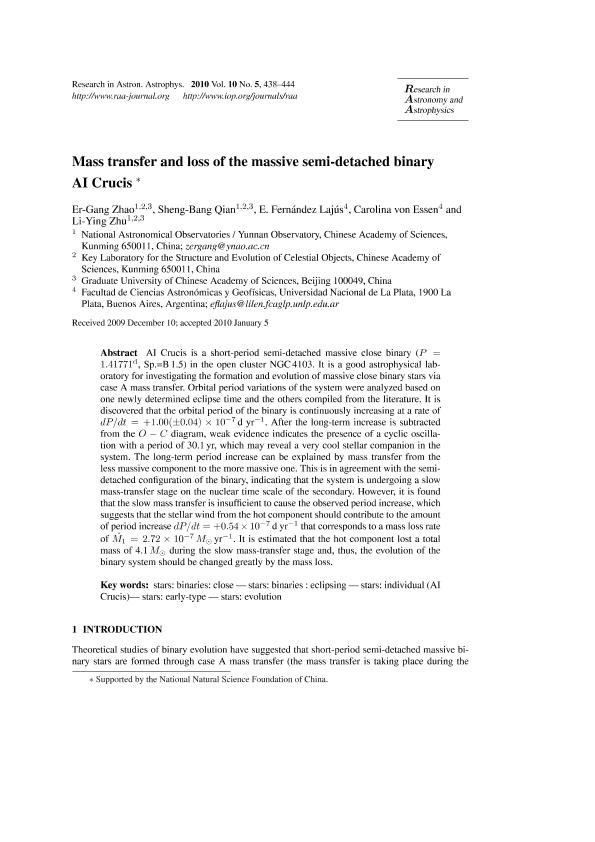Artículo
Mass transfer and loss of the massive semi-detached binary AI Crucis
Zhao, Er Gang; Qian, Sheng Bang; Fernandez Lajus, Eduardo Eusebio ; Vonn Essen, Carolina; Zhu, Li Ying
; Vonn Essen, Carolina; Zhu, Li Ying
 ; Vonn Essen, Carolina; Zhu, Li Ying
; Vonn Essen, Carolina; Zhu, Li Ying
Fecha de publicación:
05/2010
Editorial:
Natl Astronomical Observatories
Revista:
Research In Astronomy And Astrophysics
ISSN:
1674-4527
Idioma:
Inglés
Tipo de recurso:
Artículo publicado
Clasificación temática:
Resumen
AI Crucis is a short-period semi-detached massive close binary (P = 1.41771d, Sp. = B 1.5) in the open cluster NGC 4103. It is a good astrophysical laboratory for investigating the formation and evolution of massive close binary stars via case A mass transfer. Orbital period variations of the system were analyzed based on one newly determined eclipse time and the others compiled from the literature. It is discovered that the orbital period of the binary is continuously increasing at a rate of dP/dt = +1.00(±0.04) × 10−7 d yr−1. After the long-term increase is subtracted from the O – C diagram, weak evidence indicates the presence of a cyclic oscillation with a period of 30.1 yr, which may reveal a very cool stellar companion in the system. The long-term period increase can be explained by mass transfer from the less massive component to the more massive one. This is in agreement with the semidetached configuration of the binary, indicating that the system is undergoing a slow mass-transfer stage on the nuclear time scale of the secondary. However, it is found that the slow mass transfer is insufficient to cause the observed period increase, which suggests that the stellar wind from the hot component should contribute to the amount of period increase dP/dt = +0.54 × 10−7 d yr−1 that corresponds to a mass loss rate of M1 = 2.72 × 10−7 M⊙ yr−1. It is estimated that the hot component lost a total mass of 4.1 M⊙ during the slow mass-transfer stage and, thus, the evolution of the binary system should be changed greatly by the mass loss.
Archivos asociados
Licencia
Identificadores
Colecciones
Articulos(IALP)
Articulos de INST.DE ASTROFISICA LA PLATA
Articulos de INST.DE ASTROFISICA LA PLATA
Citación
Zhao, Er Gang; Qian, Sheng Bang; Fernandez Lajus, Eduardo Eusebio; Vonn Essen, Carolina; Zhu, Li Ying; Mass transfer and loss of the massive semi-detached binary AI Crucis; Natl Astronomical Observatories; Research In Astronomy And Astrophysics; 10; 5; 5-2010; 438-444
Compartir
Altmétricas



